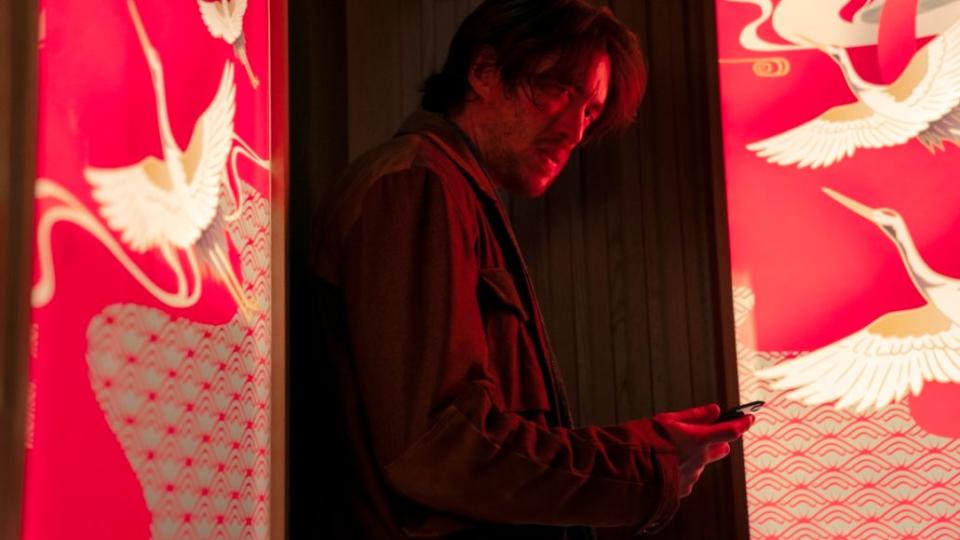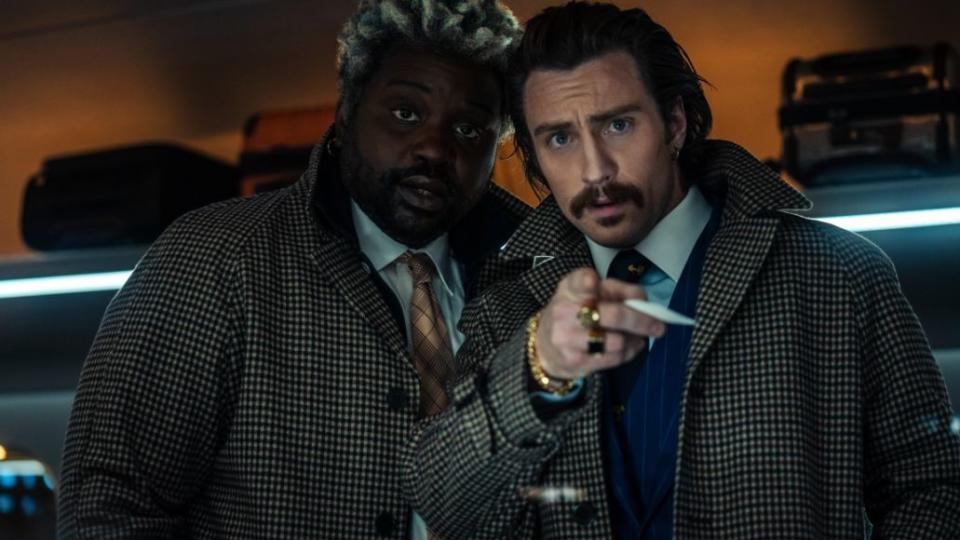Brad Pitt’s Bullet Train Gets Derailed By Its Smarmy Sense of Humor: Review
The post Brad Pitt’s Bullet Train Gets Derailed By Its Smarmy Sense of Humor: Review appeared first on Consequence.
The Pitch: Aboard one of Japan’s rocket-fast Shinkansen bullet trains, speeding from Tokyo to Kyoto at more than 300 kilometers per hour, several sets of hitmen, gangsters, and enforcers are about to careen across each other’s paths.
There’s Ladybug (Brad Pitt), a washed-up assassin with horrible luck and a new Zen outlook, who’s taking on his first smash-and-grab after a job gone bad; Lemon (Brian Tyree Henry) and Tangerine (Aaron Taylor-Johnson), a pair of Cockney enforcers and lifelong besties tasked with transporting a legendary crime boss’ failson (Logan Lerman) back home; Yuichi (Andrew Koji), a yakuza assassin with vengeance on the brain, and The Prince (Joey King), the murderously ambitious teen who has him around her little finger; and several other ostentatious killers like The Wolf (Bad Bunny) and The Hornet (Zazie Beetz) who each have their own targets on the train.
Before long, they’ll all figure out their respective connections, and it’ll be a knock-down, drag-out brawl to see which of them makes it to the end of the line.
Weeb of Intrigue: There are movies that, even as they style themselves as “original” tentpoles that aren’t tied to a superhero franchise or existing IP, are still limp pastiches of a million things that came before. Such is the case with Bullet Train, the latest from David “I co-directed the first John Wick and have been coasting ever since” Leitch, adapting an otherwise sly novel from Kōtarō Isaka (with screenwriter Zak Olkewicz) into a candy-colored mishmash of self-satisfied gags and occasionally diverting action.
To its credit, Bullet Train lets you know exactly what it is right from the get-go: It introduces its characters with garish neon title cards showing the English and Japanese spellings of their names; Pitt’s Ladybug is first seen strutting to a Japanese cover of The Bee Gees’ “Staying Alive.” Elisabet Ronaldsdottir’s frenetic editing whip-cracks us from other character intros to fourth-wall-breaking rundowns of their murderous exploits, like when Lemon and Tangerine try to break down the sixteen (or is it seventeen?) body massacre they just committed earlier in the day. (It’s all very cheeky, don’t you see.) It’s intermittently entertaining, as we struggle to figure out just how all these disparate storylines will merge across the various sections of the train.
Bullet Train (Sony Pictures Entertainment)
It’s not long, however, before the overbearing quirkiness of the aesthetic (and the innate Orientalism inherent to the film’s framing) starts to wear on you. This is a film enamored with signposts of Japanese culture — yakuza in suits, katanas, honorable samurai mob bosses (including Hiroyuki Sanada’s “Elder”) speaking earnestly of honor and family, garish anime mascots — but sees fit to center the story on a whole bunch of white people who seem casually bemused by what they see around them.
What Japanese characters actually make it into the cast feel incidental to the setting; Yuichi is our entry point into the story in the first few scenes of the film, but spends most of his runtime brought to heel by a teenage girl. (It’s also a waste of the great Andrew Koji of “Warrior” fame, who only gets to show his considerable action chops at the very end.)
Pitted Against Each Other: Then there’s Pitt, the A-list glue keeping Bullet Train on its rails and maybe the biggest liability to its narrative infrastructure. The idea of his character is a solid one: What if John Wick was also The Dude, a man capable of incredible feats of action but who’d rather talk it out and help everyone find their zen? In the early stretches, Pitt’s easygoing demeanor and half-lidded Poirot act work for the character, especially as this kind of surfer-dude pacifism comes face to face with folks trying to murder him. But over the next two hours, it’s clear that the whole murder-yogi thing is basically his only character trait, and Pitt feels constrained playing that one note (every other line of his is a variation on “Oh come on, bro, seriously?”).
At least Henry and Taylor-Johnson fare far better within the constraints of Olkewicz’s script, handling their characters’ one-dimensional quirks (Lemon is a Cockney hardass, Tangerine the softie who’s obsessed with Thomas the Tank Engine) with some fun chemistry. They’re about the only ones who get the appropriate twinkle in their eye, enough to make you wish they were the film’s real leads.
Bullet Train (Sony Pictures Entertainment)
When the cat-and-mouse game devolves into fisticuffs, the action is occasionally diverting, Leitch making inventive use of the constrained yet gaudy bullet-train setting. Fights break out in the “quiet car,” with both participants desperate to not disturb the other passengers; another melee has to stop mid-punch to let the snack cart girl through, acquiring a snack along the way.
But by the film’s high-octane final act, all that invention and restraint gives way to boom-boom-pow CGI soup, and our characters fighting off hosts of masked gang members we have no relationship to. (It’s also here that the film’s real surprise villain appears, one of a few self-indulgent cameos the film is desperate for you to enjoy. Your mileage may vary, suffice to say.)
The Verdict: There’s a universe where Bullet Train works — lean harder into the gaudy, neon-pop anime aesthetic, ditch the too-clever character work, and add some honest-to-God jokes into the mix. Unfortunately, as it stands, Bullet Train feels like a lost spec script from the mid-2000s, given a fresh new coat of paint and a few script reworks by some Reddit teens. In typical Leitch fashion, the fights are functional and fun, albeit without the signature flash that made the John Wicks such stunning accomplishments (that seems to be more Chad Stahelski’s bag).
Really, what dooms this movie is the Deadpool effect, the overarching feeling that the filmmakers think their jokes and quips are a lot more clever than they are, where mugging for the camera is sufficient to carry an otherwise tedious genre exercise. But when your script insists upon itself to this degree, it’s best to go back to the drawing board to see whether you can write some gags that aren’t as telegraphed or hokey.
To be sure, we all hearken back to the good old days of Quentin Tarantino, Robert Rodriguez, and early Guy Ritchie, and their hyper-stylized tales of murderous misfits and their fast-paced bon mots. But if Bullet Train proves anything, it’s just how difficult it is to truly nail what those filmmakers were putting down. The budget may be big, and the stars even bigger, but no amount of money can replicate the anarchic feel of one of their pictures.
Where’s It Playing? Bullet Train speeds into theaters with a little too much pep in its step on August 5th.
Trailer:
Brad Pitt’s Bullet Train Gets Derailed By Its Smarmy Sense of Humor: Review
Clint Worthington
Popular Posts
Guy Fieri Can't Stop Going to Rage Against the Machine Concerts
Statues of Walter White and Jesse Pinkman Unveiled in Albuquerque
Metallica Salute Stranger Things' Eddie Munson with Epic "Master of Puppets" at Lollapalooza: Watch
Lollapalooza 2022: j-hope Kicks Off a New Era for BTS: Recap, Photos + Setlist
Kendrick Lamar Responds to Viral Video of Security Guard Crying at His Show



